
Quercus garryana is an oak tree species of the Pacific Northwest, with a range stretching from southern California to southwestern British Columbia. It is commonly known as the Garry Oak, Oregon white oak or Oregon oak. It grows from sea level to an altitude of 690 feet in the northern part of its range, and from 980 to 5,900 ft in the south of the range in California. The eponymous Nicholas Garry was deputy governor of the Hudson's Bay Company.

Ageratina altissima, also known as white snakeroot, richweed, or white sanicle, is a poisonous perennial herb in the family Asteraceae, native to eastern and central North America. An older binomial name for this species is Eupatorium rugosum, but the genus Eupatorium has undergone taxonomic revision by botanists, and some species once included in it have been moved to other genera.

Purshia tridentata, with the common name bitterbrush, is a shrub in the genus Purshia of the family Rosaceae. It is native to mountainous areas of western North America.
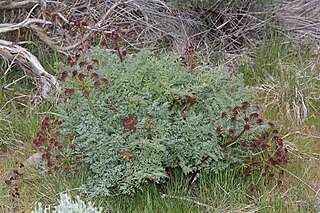
Lomatium dissectum is a species of flowering plant in the carrot family known by the common names fernleaf biscuitroot, fernleaf desert parsley, carrotleaf biscuitroot, chocolate tips and coastal chocolate-tips
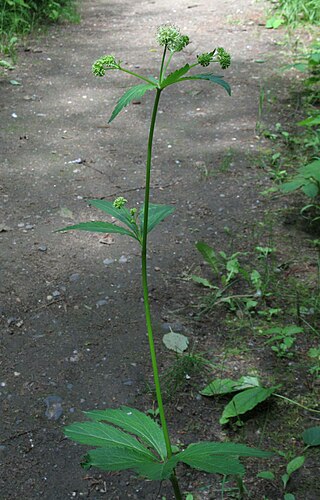
Sanicula marilandica, the Maryland sanicle or Maryland black snakeroot, is a flowering plant widespread in North America but rare along the Pacific coast of the continent and Texas. Sanicula marilandica is listed as Sensitive in Washington state.
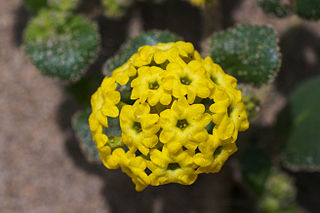
The perennial flower Abronia latifolia or Abronia arenaria is a species of sand-verbena known commonly as the coastal sand-verbena, or yellow sand-verbena. It is native to the west coast of North America, from southern California to southern British Columbia. In Canada, it is at risk of becoming extirpated, threatened, or endangered.

Sanicula arctopoides is a species of sanicle known commonly as footsteps of spring, bear's foot sanicle or yellow mats. It is a perennial herb found on the west coast of the United States and Canada, especially near the ocean. The branches are short and thick and may be prostrate or slightly erect. The leaves are yellowish-green and carrot-like or maple-shaped, and the tiny yellow flowers are borne in umbels with prominent bracts. The plants grow in low matted patches along the ground, resembling "footsteps" of yellow against the background.

Sanicula bipinnata is a species of plant in the family Apiaceae known by the common name poison sanicle. It is endemic to California where it is found in low-elevation mountains and foothills, especially in the hills along the coast. It occurs in the California Coastal Range and Sierra Nevada foothills, including Ring Mountain, California.

Lomatium columbianum is a perennial herb of the family Apiaceae known by the common names purple leptotaenia and Columbia desert parsley. It is endemic to the U.S. states of Oregon and Washington, mostly along the Columbia River east of the Cascades.

Lomatium grayi, commonly known as Gray's biscuitroot, Gray's desert parsley, or pungent desert parsley, is a perennial herb of the family Apiaceae. It is native to Western Canada in British Columbia, and the Western United States, including from the Eastern Cascades and northeastern California to the Rocky Mountains.
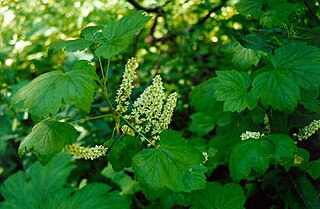
Ribes hudsonianum is a North American species of currant, known by the common name northern black currant.

Sanicula bipinnatifida is a species of flowering plant in the parsley family known by the common names purple sanicle, purple black-snakeroot, and shoe buttons.
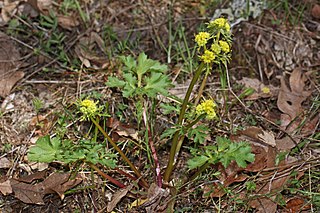
Sanicula graveolens is a species of flowering plant in the family Apiaceae known by the common names northern sanicle and Sierra blacksnakeroot. It is native to western North America from British Columbia to Montana to California, and southern South America, including southern Chile. Its habitat includes mountain slopes, forests, and woodlands on serpentine soils. It is a perennial herb producing a slender, branching stem up to half a meter tall from a taproot, with leaves alternate. The lowest leaves have long stalks and are often attached below ground. The upper leaves are smaller, sparse and often sessile. The leaves are compound, the blades each divided into three deeply lobed, toothed leaflets. The herbage is green to purple-tinged to all purple in color. The inflorescence is made up of one or more heads of bisexual and male-only flowers with tiny, curving, yellow petals. Each head has an array of narrow, toothed bracts at its base. The rounded fruits are a few millimeters long, covered in curving prickles, and borne in small clusters.
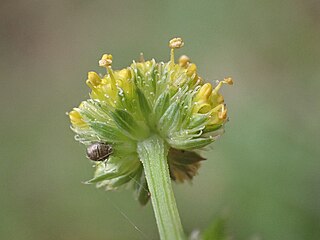
Sanicula hoffmannii is an uncommon species of flowering plant in the family Apiaceae known by the common names Hoffmann's blacksnakeroot and Hoffmann's sanicle. It is endemic to California, where it is known from the Channel Islands and a few locations in the coastal mountain ranges of the mainland, including the Scott Creek watershed in Santa Cruz County. Its habitat includes coastal hillsides and mountain slopes, sometimes with serpentine soils. It is a perennial herb producing a thick stem up to 90 centimeters tall from a taproot. The green or bluish leaves are compound, the blades each divided into about three lobed, toothed leaflets. The inflorescence is made up of one or more heads of bisexual and male-only flowers with tiny, curving, yellow-green petals.

Sanicula maritima is a rare species of flowering plant in the parsley family known by the common names adobe snakeroot and adobe sanicle.

Sanicula peckiana is an uncommon species of flowering plant in the family Apiaceae known by the common names Peck's blacksnakeroot and Peck's sanicle. It is native to the Klamath Mountains of southern Oregon and far northern California, where it grows in chaparral and woodland habitat, often on serpentine soils. It is a perennial herb growing to a maximum height near 40 centimeters. The leaves are simple or divided into a number of lobes, the edges generally with sharp teeth. The inflorescence is made up of one or more heads of bisexual and male-only flowers with tiny, curving, yellow petals. The fruits are borne singly or in heads of up to five, each fruit covered in bumpy tubercles and sometimes with prickles near the tip.

Sanicula saxatilis is a rare species of flowering plant in the parsley family known by the common names devil's blacksnakeroot and rock sanicle.

Sanicula tracyi is a species of flowering plant in the family Apiaceae known by the common names Tracy's blacksnakeroot and Tracy's sanicle. It is endemic to northwestern California, where it is known from woodlands and coniferous forest in hills and mountains. It is a perennial herb producing a slender stem up to about 60 centimeters tall from a taproot. The leaves are compound, divided into usually three leaflets which are deeply cut into lobes and serrated along the edges. The herbage is green to purple in color. The inflorescence is made up of one or more heads of bisexual and male-only flowers with tiny, curving, yellow petals. The fruits are 2 or 3 millimeters long, each fruit covered in bumpy tubercles and sometimes with prickles near the tip.

Orbexilum pedunculatum, commonly known as Sampson's snakeroot, is a species of flowering plant in the legume family. It is native primarily to the Southeastern United States where it is found in prairies and savannas, often in acidic soil. It is a perennial that produces racemes of flowers in early summer.

Erigeron poliospermus is a species of flowering plant in the family Asteraceae known by the common names gray-seeded fleabane, purple cushion fleabane, and hairy-seed fleabane. Native to western North America, it is mainly found to the east of the Cascade Range in Washington, Oregon, and Idaho.






















